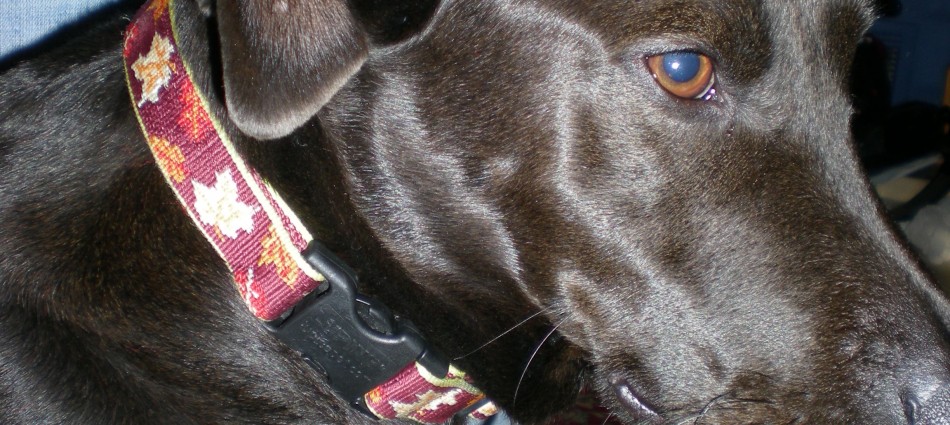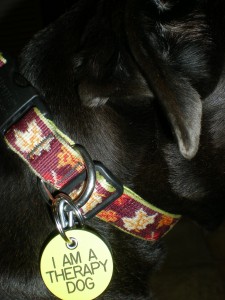Pick-up Dogs How Two Rescue Dogs Save the West from Being Won

What is a therapy dog?
 When somebody mentioned to me that my Lab/greyhound mix Marcos would make a perfect therapy dog, I had to respond, “What’s a therapy dog?” My friend explained that a therapy animal provides affection and comfort to people in hospitals, nursing homes and other situations in which people need relief from suffering. I must admit that there was a skeptical part of me that said that it sounded like some kind of animal mysticism.
When somebody mentioned to me that my Lab/greyhound mix Marcos would make a perfect therapy dog, I had to respond, “What’s a therapy dog?” My friend explained that a therapy animal provides affection and comfort to people in hospitals, nursing homes and other situations in which people need relief from suffering. I must admit that there was a skeptical part of me that said that it sounded like some kind of animal mysticism.
Nevertheless, using animals as healers is an age-old practice. In pre-Hispanic Mexico, the Mexica culture believed that the xoloitzcuintle, an adorably ugly dog that usually appears bald except for a mohawk and a clump of hair on the tail, was a sacred animal that was as a key that unlocked the door between the real and supernatural worlds. According to the Mexica beliefs, the xoloitzcuintle served as a guide who took dead people on their path to Mictlan, the land of the dead. To get there, spirits of the dead needed to cross a river by grabbing the red collar of their dog, who would lead them across the river to a resting spot. This is why the Mexicas were buried with their dogs.
The jackal, cousin to Canis lupus familiaris, also served as a guide for the souls of the dead in Egyptian lore.This ancient mythical representation of dogs as the epitome of companionship tells us a lot about how we view our relationships with dogs now. Indeed, as messengers between the worlds of the living and the dead, dogs have also provided a link between the human and the animal kingdom. As four-legged angels, they have and probably always will be our truest animal companions.
For many thousands of years, dogs have participated in a symbiotic relationship with humans; in this way, they have been intrinsically linked to our successes and failures. Because we have spent thousands of years evolving together, dogs have defined who we are. Wild animals, companion animals, service animals, working animals, domestic animals and therapy animals all mean different things, but their functions overlap in the sense that the modifiers—wild, companion, service, working, domestic, therapy—demonstrate dogs’ interactions with humans and humans’ interactions with the earth and each other. In other words, domestic animals, particularly dogs, have gone from being camp scavengers to farm tools to family members and best friends, and along the way they have known a lot of other existences. And even though “wild” and “domestic” represent opposite poles of the human-animal relationship, wild animals still measure humans’ relationship with nature. Throughout the millennia, still connected to their wolf ancestors, dogs have acted as mediators between civilization and wildness, and therefore represent a link to the earth that is fundamental to healing, which is really about getting reconnected with the natural world in an effort to fix us.
It turns out that the founder of therapy dog work in the States brought the concept of therapy dogs here after working as a nurse in England. In her foreword to Karin Winegar’s Saved, a book that recounts how animals can save their humans, Jane Goodall tells of the first officially documented therapy dog, a white stray that frequented a children’s hospital in London. At the ward, this dog sought out the sickest children and often curled up next to them to make them feel better. A hygiene inspector had banned the little dog from the hospital, but death rates reportedly increased, and the hospital eventually invited him back to stay.
Animals listen in a way that very few human beings are capable. Dogs can be present in ways that we can’t because that has been their function since the time when they went from being wild wolves to domesticated companions. This bond, this mutual need, is why dogs make such great therapy animals.
Even with all the findings about the health benefits of spending time with dogs, smiles are the most common response to Marcos’s visits to assisted care living homes, hospices and hospital wards. On our first visit ever as a therapy dog-handler team, the activities director at an assisted living center for elderly people with dementia, asked if anybody there had had a dog. A great number responded affirmatively. Marcos’s visit, just a brief break in their day, was a great way for them to travel back to a another time when they had dogs. I could only imagine that these time travels were a welcome part of their day.
When I visit nursing homes and psychiatric wards with Marcos, he wears a tag that clearly identifies him as a therapy dog: “I AM A THERAPY DOG.” I thought this was so cool when I first got it in the mail from the organization through which he is licensed. And I still do, but when I see Marcos in action, I just see a dog being a dog. He is doing what naturally comes to him: being a companion to others, and insisting that people pet him. Besides, just about all dogs have the capacity to be therapeutic.
People commonly confuse therapy and service animals. Marcos is not trained to sniff out cancer nor alert an emergency response team when his charge is having an epileptic seizure. Marcos would not be able to guide a blind person down the street; meeting new friends and seeking out ice cream cones would distract him. Marcos can’t help balance someone with MS. But one thing he can do, like just about all dogs, is remain true to his buddies. And that is the greatest gift our companion animals can offer us. And a therapy dog is an animal certified to provide this companionship in institutions like hospitals, libraries and hospices.
Pick-Up Dogs is an adventure road trip story about the healing power of dogs. Click here to buy the book
2 Responses to What is a therapy dog?